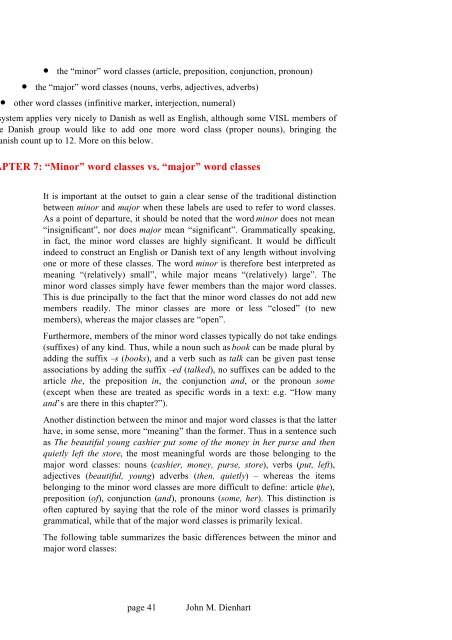Download - VISL
Download - VISL
Download - VISL
Create successful ePaper yourself
Turn your PDF publications into a flip-book with our unique Google optimized e-Paper software.
• the “minor” word classes (article, preposition, conjunction, pronoun)<br />
• the “major” word classes (nouns, verbs, adjectives, adverbs)<br />
• other word classes (infinitive marker, interjection, numeral)<br />
ystem applies very nicely to Danish as well as English, although some <strong>VISL</strong> members of<br />
Danish group would like to add one more word class (proper nouns), bringing the<br />
nish count up to 12. More on this below.<br />
PTER 7: “Minor” word classes vs. “major” word classes<br />
It is important at the outset to gain a clear sense of the traditional distinction<br />
between minor and major when these labels are used to refer to word classes.<br />
As a point of departure, it should be noted that the word minor does not mean<br />
“insignificant”, nor does major mean “significant”. Grammatically speaking,<br />
in fact, the minor word classes are highly significant. It would be difficult<br />
indeed to construct an English or Danish text of any length without involving<br />
one or more of these classes. The word minor is therefore best interpreted as<br />
meaning “(relatively) small”, while major means “(relatively) large”. The<br />
minor word classes simply have fewer members than the major word classes.<br />
This is due principally to the fact that the minor word classes do not add new<br />
members readily. The minor classes are more or less “closed” (to new<br />
members), whereas the major classes are “open”.<br />
Furthermore, members of the minor word classes typically do not take endings<br />
(suffixes) of any kind. Thus, while a noun such as book can be made plural by<br />
adding the suffix –s (books), and a verb such as talk can be given past tense<br />
associations by adding the suffix –ed (talked), no suffixes can be added to the<br />
article the, the preposition in, the conjunction and, or the pronoun some<br />
(except when these are treated as specific words in a text: e.g. “How many<br />
and’s are there in this chapter?”).<br />
Another distinction between the minor and major word classes is that the latter<br />
have, in some sense, more “meaning” than the former. Thus in a sentence such<br />
as The beautiful young cashier put some of the money in her purse and then<br />
quietly left the store, the most meaningful words are those belonging to the<br />
major word classes: nouns (cashier, money, purse, store), verbs (put, left),<br />
adjectives (beautiful, young) adverbs (then, quietly) – whereas the items<br />
belonging to the minor word classes are more difficult to define: article (the),<br />
preposition (of), conjunction (and), pronouns (some, her). This distinction is<br />
often captured by saying that the role of the minor word classes is primarily<br />
grammatical, while that of the major word classes is primarily lexical.<br />
The following table summarizes the basic differences between the minor and<br />
major word classes:<br />
page 41<br />
John M. Dienhart
















